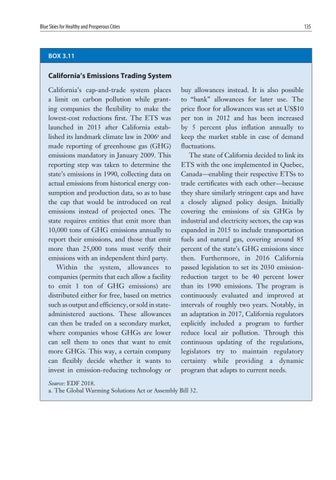Blue Skies for Healthy and Prosperous Cities
135
BOX 3.11
California’s Emissions Trading System California’s cap-and-trade system places a limit on carbon pollution while granting companies the flexibility to make the lowest-cost reductions first. The ETS was launched in 2013 after California established its landmark climate law in 2006a and made reporting of greenhouse gas (GHG) emissions mandatory in January 2009. This reporting step was taken to determine the state’s emissions in 1990, collecting data on actual emissions from historical energy consumption and production data, so as to base the cap that would be introduced on real emissions instead of projected ones. The state requires entities that emit more than 10,000 tons of GHG emissions annually to report their emissions, and those that emit more than 25,000 tons must verify their emissions with an independent third party. Within the system, allowances to companies (permits that each allow a facility to emit 1 ton of GHG emissions) are distributed either for free, based on metrics such as output and efficiency, or sold in stateadministered auctions. These allowances can then be traded on a secondary market, where companies whose GHGs are lower can sell them to ones that want to emit more GHGs. This way, a certain company can flexibly decide whether it wants to invest in emission-reducing technology or
buy allowances instead. It is also possible to “bank” allowances for later use. The price floor for allowances was set at US$10 per ton in 2012 and has been increased by 5 percent plus inflation annually to keep the market stable in case of demand fluctuations. The state of California decided to link its ETS with the one implemented in Quebec, Canada—enabling their respective ETSs to trade certificates with each other—because they share similarly stringent caps and have a closely aligned policy design. Initially covering the emissions of six GHGs by industrial and electricity sectors, the cap was expanded in 2015 to include transportation fuels and natural gas, covering around 85 percent of the state’s GHG emissions since then. Furthermore, in 2016 California passed legislation to set its 2030 emissionreduction target to be 40 percent lower than its 1990 emissions. The program is continuously evaluated and improved at intervals of roughly two years. Notably, in an adaptation in 2017, California regulators explicitly included a program to further reduce local air pollution. Through this continuous updating of the regulations, legislators try to maintain regulatory certainty while providing a dynamic program that adapts to current needs.
Source: EDF 2018. a. The Global Warming Solutions Act or Assembly Bill 32.






